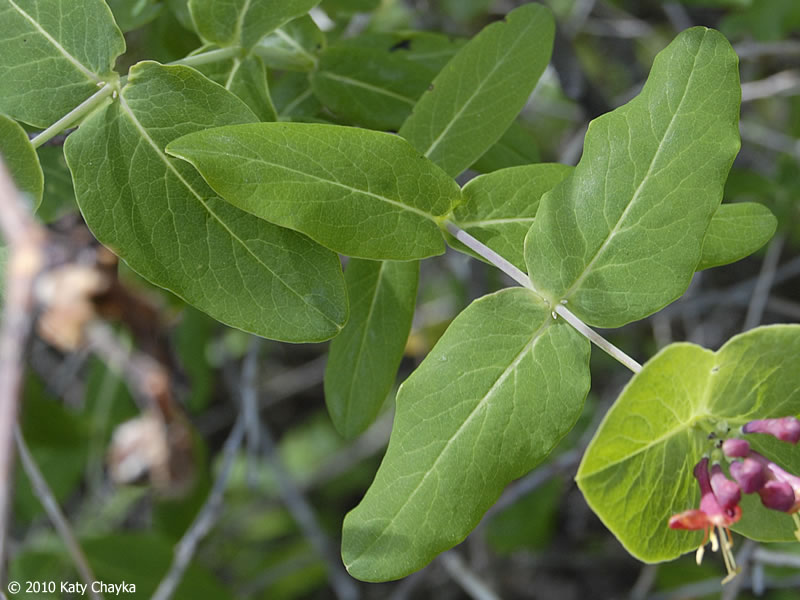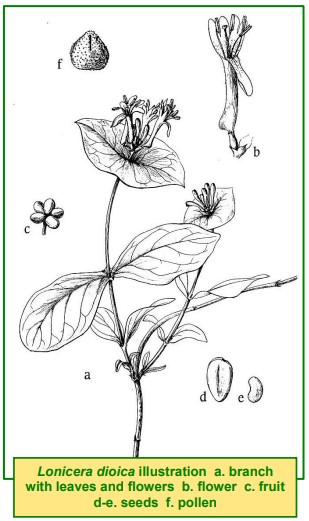This week, I’m featuring Glaucous Honeysuckle (Lonicera dioica) as one of our local wildflowers that begins to bloom at this time.


The scientific name Lonicera pays tribute to the 16th century German botanist Adam Lonicer, while dioica means “two houses,” and comes from an initial mistake by Carl Linnaeus, the Swedish botanist who assigned this plant with its scientific name, who thought the plant was dioecious, i.e., with male flowers and female flowers on separate plants. The common name of honeysuckle comes from the “honey” or nectar that can be easily sucked from the flower.
If you’re interested in an assessment of the status of this species nationwide, read this informative technical report.
Identification Tips:
Glaucous Honeysuckle is a woody, loosely twining perennial vine, up to ¾” in diameter and 10 feet long, with branches that sprawl or climb on nearby vegetation.

https://www.minnesotawildflowers.info/shrub/wild-honeysuckle#lboxg-7
Young stems have a waxy, bluish-white coating (glaucous) while older woody stems are brown or grayish bark with long, fibrous, shredding, peeling strips. Twigs are green and hairless. Branches are twining and may take root when they touch the ground, forming clonal plants.

https://www.minnesotawildflowers.info/shrub/wild-honeysuckle#lboxg-3
Leaves are opposite, 1½ to 3½ inches long, 1 to 2½ inches wide, somewhat variable in shape, from lance-elliptical to egg-shaped to widest above the middle (obovate), rounded to blunt at the tip, and mostly rounded at the base. Leaf margins are toothless, hairless and often a bit wavy. The upper surface is dark green and hairless, the lower a paler blue-green color and typically short-hairy, but may be hairless. Besides the leaf pair at the tip of a flowering branch, the next 1 or 2 pairs below that may also be joined around the stem (perfoliate). Otherwise, leaves are stalkless or short stalked; stalks may be hairy. Leaves below flowers are fused together at the base into a single disk-like leaf.
A single cluster of distinctive, red, tubular flowers with yellow stamens are arranged at the tips of one-year-old branches; each cluster consists of 1 to 5 whorls each with 6 stalkless flowers. The whorls are not separated and the flowers are crowded. Flowers are ½ to 1 inch long with a 5 petals fused at the base into a corolla tube then separated ⅓ to ½ of the way to the base into 2 lips; the upper is broad with 4 lobes and the lower is narrow. Flower color is typically deep red to maroon, sometimes yellow and sometimes becoming yellow with age. Outer surface is hairless, inner surface is hairy, especially in the throat.

Afterwards, the flowers are replaced by round to oval, bright red to orange-red berries that are ¼ to ½ inch long and grow in clusters surrounded by joined upper leaves. Berries are green initially, becoming orange, ultimately red or orange-red when ripe. They do not fall from the plant; instead, they remain on it unless picked off by birds.

https://www.minnesotawildflowers.info/shrub/wild-honeysuckle#lboxg-5
There are 3 to 8 ovoid yellow seeds in each berry. The Arikara of the Northern Great Plains inserted these seeds into dried gourds as the noisemakers in rattles that were employed in ceremonial rituals.

The deciduous leaves of Glaucous Honeysuckle become yellow or gold during autumn.

Folklore:
It is said that the meaning of wild honeysuckle flowers indicates “inconstant love,” which seems supported by the belief that the color of flowers corresponds to the specific type of happiness contained in the honeysuckle flower’s meaning. For example, in the language of flowers, white typically represents innocence, yellow represents friendship, pink represents flirtation, and red represents passion. While most Glaucous Honeysuckle blooms are red, sometimes this species exhibits merely yellow blooms.
Culinary and Medicinal Uses:
The fruit of Glaucous Honeysuckle is mildly toxic and not used for food.
The Algonquin, Chippewa, and Meskwaki used Glaucous Honeysuckle to treat fever, tuberculosis, menstrual difficulties, kidney stones, dysuria, venereal disease, and worms and as a cathartic and a diuretic. The Iroquois made a decoction of the vines and used it as an emetic “to throw off effects of love medicine.”
Wildlife Value:
Flowers attract bumblebees (including, but not limited to, Yellow-banded Bumblebee (Bombus terricola)), Halictid bees, Mason bees (Osmia spp.), and Ruby-throated Hummingbird (Archilochus colubris).
Avian frugivores feed on the berries of this plant, including: American Goldfinch (Spinus tristis), American Robin (Turdus migratorius), Cedar Waxwing (Bombycilla cedrorum), Gray Catbird (Dumetella carolinensis), Northern Cardinal (Cardinalis cardinalis), Northern Mockingbird (Mimus polyglottos), Purple Finch (Haemorhous purpureus), and White-throated Sparrow (Zonotrichia albicollis).
Where Found Locally:
